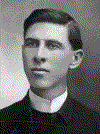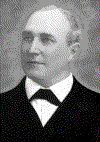A Brief History of the Pentecostal Holiness Church
Part Three
The Fire-Baptized Holiness Church
The Fire-Baptized Holiness Church came into being as the result of the evangelistic ministry of Benjamin Hardin Irwin of Nebraska. A Baptist lawyer converted to Wesleyan holiness theology, Irwin postulated a "baptism with fire" following the experience of sanctification.
From 1896 to 1900, Irwin's preaching campaigns in the Midwest and South resulted in large numbers of followers from the holiness movement, many of whom were also attracted to his healing ministry. When leaders of the National Holiness Movement rejected his teaching as "third blessingism," Irwin began to organize Fire-Baptized Holiness Associations around the nation, the first of which was organized in Olmitz, Iowa, in 1895.
From 1896 to 1900, Irwin's preaching campaigns in the Midwest and South attracted large crowds, including many holiness ministers. At Anderson, South Carolina, in August 1898, Irwin led in the formation of a national body known as the Fire-Baptized Holiness Association. Irwin was elected to serve as "general overseer" for life while "ruling elders" were appointed over eight states and two Canadian provinces. A periodical promoting the movement, Live Coals of Fire, was published in Lincoln, Nebraska.

When Irwin left the movement in 1900, Joseph Hillery King (right) was chosen to serve as general overseer. In 1902 the name was changed from Fire-Baptized Holiness Association to the Fire-Baptized Holiness Church.
Pentecost and Mergers

Soon after the outpouring of the Holy Spirit at Azusa Street in 1906, members of both churches were attracted to the experience of speaking in tongues as evidence of the baptism in the Holy Spirit. In 1906, G. B. Cashwell (left), a minister in the Holiness Church of North Carolina, journeyed to Los Angeles where he received the pentecostal baptism in the Holy Spirit in the Azusa Street mission.
In a historic meeting in Dunn, North Carolina, in January of 1907, Cashwell led many of the leaders of the Southern Holiness Movement into the pentecostal experience. Soon both the Holiness Church of North Carolina and the Fire-Baptized Holiness Church embraced the doctrine of the baptism in the Holy Ghost, evidenced by speaking in tongues.
In the next few years a strong feeling arose among the members of both denominations that these two groups should unite. Both were preaching the same basic doctrines, were operating in the same territory, and had experienced a growing fellowship over the years. After several preliminary steps were taken during 1909 and 1910, these two groups consolidated in 1911.
The merger took place on January 30, 1911, in the octagon-shaped Pentecostal Holiness Church building at Falcon, North Carolina. Here duly elected delegates from the Pentecostal Holiness Church and the Fire-Baptized Holiness Church met for the purpose of effecting a consolidation of the two bodies. Although the Fire-Baptized Holiness Church was much larger, the name Pentecostal Holiness Church was adopted for the new organization. G. F. Taylor, F. M. Britton, and J. A. Culbreth served as the committee to draw up the Discipline which became the basis upon which the consolidation was made. The first general superintendent of the united church was Samuel Daniel Page.
Organizational Developments
The first general conference after the merger was held at Toccoa, Georgia, in 1913, at which time the change from biennial to quadrennial meetings was affected. At the time of the merger, missionaries sent by both churches already had opened fields in Hong Kong, China, Africa, and India.
In 1915 at Canon, Georgia, the Tabernacle Pentecostal Church consolidated with the Pentecostal Holiness Church. This merger brought the Holmes Bible and Missionary Institute of Greenville, South Carolina, into the fellowship of the church. The founder of both the Tabernacle Pentecostal Church and the Bible Institute was Nickels John Holmes of Greenville.
Early missions work of the combined churches included the Hong Kong field begun by Anna Dean in 1909; the Indian field opened by Della Gaines in 1910; the South African field started by J. O. Lehman in 1913; and the Central American field opened by Amos Bradley in 1913. Later efforts by K. E. M. Spooner (1915) and D. D. Freeman (1924) in Africa; W. H. Turner (1919) in China; and J. M. Turner in India (1921) greatly strengthened the early overseas missions of the church.
 In 1917, the church began publication of an official journal known as the Pentecostal Holiness Advocate (first publishing building pictured on left). The first editor was George Floyd Taylor. Two years later, in 1919, Taylor also founded the Franklin Springs Institute near Royston, Georgia. In 1933 the name of the school was changed to Emmanuel College.
In 1917, the church began publication of an official journal known as the Pentecostal Holiness Advocate (first publishing building pictured on left). The first editor was George Floyd Taylor. Two years later, in 1919, Taylor also founded the Franklin Springs Institute near Royston, Georgia. In 1933 the name of the school was changed to Emmanuel College.
Foreign missions work opened in this period included Argentina, started by Janet Hart in 1931; the Mexico field, founded by Esteban Lopez in 1933; and the Hawaiian field, founded in 1936 by Mildred Johnson Brostek.
In 1937 at Roanoke, Virginia, the honorary title of bishop was bestowed on the general superintendents. The two general superintendents elected at that conference, Joseph H. King and Dan T. Muse, were the first to bear this title.
At the general conference in Oklahoma City, Oklahoma, in 1945, the church voted to have four general superintendents. Elected to serve with King and Muse were Joseph A. Synan (left)and Hubert T. Spence. At the death of Bishop King in 1946, Muse assumed the leadership of the church. He served as presiding bishop until his death in 1950 when he was succeeded by J. A. Synan who served as chairman until 1969.
After twenty years of changing the number of bishops, the 1957 General Conference that convened in Oklahoma City decided henceforth to have only one general superintendent.
During the 1950s the church experienced rapid expansion in the mission fields. Works were opened in this period in Costa Rica, Cuba, Northern and South Rhodesia, Zambia, Zimbabwe, Malawi, Nigeria, Mozambique, Ghana, and Botswana.
In the late 1960s affiliations were initiated with sister pentecostal bodies abroad. The first international affiliation was with the Pentecostal Methodist Church of Chile in 1967, followed by a similar agreement with the Wesleyan Methodist Church of Brazil in 1983.
J. Floyd Williams was elected general superintendent in 1969 in Memphis, Tennessee. During his tenure of office, the headquarters of the church was moved in 1974 from Franklin Springs, Georgia, to Oklahoma City, Oklahoma.
In 1981 the general conference elected Leon O. Stewart as general superintendent. He was succeeded in 1989 by Bernard E. Underwood (right), who had served as executive director of World Missions for 16 years. Underwood was reelected at the 1993 General Conference in Jacksonville, Florida.
The First World Conference of Pentecostal Holiness Churches met in September of 1990 in Jerusalem, Israel. This was a significant milestone in the church's history. There the PHC established the Target 2000 goals globally. The church adopted The Jerusalem Proclamation, which has become a global battle cry for PHC people.
Out of that meeting also came the School Of Ministry (SOM) program for equipping pastors and church planters, and the Global Desk (which is now merged into the NET). NET is an acronym for New Evangelism Technologies. The NET is an electronic communications network designed to unite the various ministries and conferences of the IPHC.
At the close of the 1994, the International Pentecostal Holiness Church consisted of 1,645 churches and nearly 4,000 licensed and ordained ministers in the United States. Membership in the U.S. was 150,133.
Update. At the close of 1999, official published statistics showed the following global totals:
8,383 Churches (1,771 in U.S.)
1,040,400 Members (184,431 in U.S.)
Those who led the churches before the consolidation at Falcon in 1911 were:
Fire-Baptized Holiness Church
1898-1900 Benjamin Hardin Irwin
1900-1911 Joseph Hillery King
Pentecostal Holiness Church of North Carolina
1898-1908 Ambrose Blackmon Crumpler
1908-1911 A. H. Butler
Those who have served as general superintendents since 1911 are:
1911-1913 Samuel Daniel Page
1913-1917 George Floyd Taylor
1917-1946 Joseph Hillery King
1937-1950 Daniel Thomas Muse
1945-1969 Joseph Alexander Synan
1945-1946 Hubert Talmage Spence
1946-1949 Paul Franklin Beacham
1946-1953 Thomas Alexander Melton
1953-1957 Oscar Moore
1969-1981 Julius Floyd Williams
1981-1989 Leon Otto Stewart
1989-1997 Bernard Edward Underwood
1997- Pres James D. Leggett